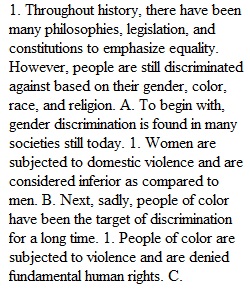


Q will cover organization and constructing an Outline in this workshop and you will submit your outline at the end of this week. This research paper does not require that you follow a specific plan like the one offered in the chapter: Introduction, Methodology and Materials, Results, Discussion, Conclusion. Many disciplines, especially those in the Social Sciences will expect such a method. For our purposes in the Humanities, you are given more freedom to construct your own plan depending on the requirements of your topic and argument. The main point, however, is that you MUST have a plan when you write a paper—even a short paper. Like most of you, I was told this over and over when I was a student. And like most of you, I ignored that advice. But when you get to graduate school, or as the case is here, when your task is a rather long and sustained argument with many working parts, then a plan is necessary. Don’t worry if you write your Outline and find that it changes as you begin writing your draft. No problem: go back and revise your Outline to reflect those changes. What you DON’T want to do is write your paper and construct an Outline based on what you wrote. That would be like taking a trip and only later mapping out your route once you arrived at your destination. The point of the Outline is to plan your paper: to create a map of where you are going and how you are going to get there. Your Outline begins with your Main Thesis and includes any minor theses (claims) that must be made in order for you to prove your point. It should build upon itself, moving from one point to the next in a rational manner that makes sense to the reader. The Outline of your paper is basically an Outline of your argument: what must you discuss in order to prove your point? Read through the discussion of the “Flawed Plans” in the chapter, taking care not to imitate those mistakes. For the Outline itself, you may use any method that you find works best: storyboard, narrative (of the argument itself, not your thinking), road map, or simple numeric outline (I, A, 1, a, B, II, etc… or 1.0, 1.1, 1.2, 1.2.1, etc…). The point is to clarify your thoughts and argument for yourself first, and then be able to communicate that in your Outline. Click here for examples of three different types of Outlines: Outlines_OWL.pdf Your Outline should consist of three main parts: Introduction, Body, Conclusion. The bulk of your Outline will be in the Body, where you are noting specifically how you will make your case. You do NOT need to label these parts of your Outline, though you may label your Introduction and Conclusion sections as such. Begin with your Main Thesis and organize your thoughts around how to prove it. What issues will you need to discuss and clarify? What minor claims will you need to state and argue? How much do context do you need to discuss before you argue your point? Where does your evidence fit? Do you have specific quotations you want to include? Consider what steps you need to take in order to prove your Main Thesis and construct your Outline based on these steps. The Purdue OWL suggests the following approach to constructing an Outline: Brainstorm: List all the ideas that you want to include in your paper. Organize: Group related ideas together. Order: Arrange material in subsections from general to specific or from abstract to concrete. Label: Create main and sub headings. The Labels themselves should conform to this general rubric: Parallelism: Each heading and subheading should preserve parallel structure. If the first heading is a verb, the second heading should be a verb. Example: CHOOSE DESIRED COLLEGES PREPARE APPLICATION ("Choose" and "Prepare" are both verbs. The present tense of the verb is usually the preferred form for an outline.) Coordination: All the information contained in Heading 1 should have the same significance as the information contained in Heading 2. The same goes for the subheadings (which should be less significant than the headings). Example: VISIT AND EVALUATE COLLEGE CAMPUSES VISIT AND EVALUATE COLLEGE WEBSITES Note important statistics Look for interesting classes (Campus and Web sites visits are equally significant. They are part of the main tasks you would need to do. Finding statistics and classes found on college Web sites are parts of the process involved in carrying out the main heading topics.) Subordination: The information in the headings should be more general, while the information in the subheadings should be more specific. Example: DESCRIBE AN INFLUENTIAL PERSON IN YOUR LIFE Favorite high school teacher Grandparent (A favorite teacher and grandparent are specific examples from the generalized category of influential people in your life.) Division: Each heading should be divided into 2 or more parts. Example: COMPILE RÉSUMÉ List relevant coursework List work experience List volunteer experience (The heading "Compile Résumé" is divided into 3 parts.) Technically, there is no limit to the number of subdivisions for your headings; however, if you seem to have a lot, it may be useful to see if some of the parts can be combined. Construct your Outline following these guidelines and the information provided in the chapter and submit it in the Assignments section.
View Related Questions